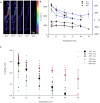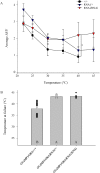cGMP-Dependent Protein Kinase Inhibition Extends the Upper Temperature Limit of Stimulus-Evoked Calcium Responses in Motoneuronal Boutons of Drosophila melanogaster Larvae
- PMID: 27711243
- PMCID: PMC5053426
- DOI: 10.1371/journal.pone.0164114
cGMP-Dependent Protein Kinase Inhibition Extends the Upper Temperature Limit of Stimulus-Evoked Calcium Responses in Motoneuronal Boutons of Drosophila melanogaster Larvae
Abstract
While the mammalian brain functions within a very narrow range of oxygen concentrations and temperatures, the fruit fly, Drosophila melanogaster, has employed strategies to deal with a much wider range of acute environmental stressors. The foraging (for) gene encodes the cGMP-dependent protein kinase (PKG), has been shown to regulate thermotolerance in many stress-adapted species, including Drosophila, and could be a potential therapeutic target in the treatment of hyperthermia in mammals. Whereas previous thermotolerance studies have looked at the effects of PKG variation on Drosophila behavior or excitatory postsynaptic potentials at the neuromuscular junction (NMJ), little is known about PKG effects on presynaptic mechanisms. In this study, we characterize presynaptic calcium ([Ca2+]i) dynamics at the Drosophila larval NMJ to determine the effects of high temperature stress on synaptic transmission. We investigated the neuroprotective role of PKG modulation both genetically using RNA interference (RNAi), and pharmacologically, to determine if and how PKG affects presynaptic [Ca2+]i dynamics during hyperthermia. We found that PKG activity modulates presynaptic neuronal Ca2+ responses during acute hyperthermia, where PKG activation makes neurons more sensitive to temperature-induced failure of Ca2+ flux and PKG inhibition confers thermotolerance and maintains normal Ca2+ dynamics under the same conditions. Targeted motoneuronal knockdown of PKG using RNAi demonstrated that decreased PKG expression was sufficient to confer thermoprotection. These results demonstrate that the PKG pathway regulates presynaptic motoneuronal Ca2+ signaling to influence thermotolerance of presynaptic function during acute hyperthermia.
Conflict of interest statement
The authors have declared that no competing interests exist.
Figures




Similar articles
-
Natural variation in the thermotolerance of neural function and behavior due to a cGMP-dependent protein kinase.PLoS One. 2007 Aug 22;2(8):e773. doi: 10.1371/journal.pone.0000773. PLoS One. 2007. PMID: 17712421 Free PMC article.
-
Characterization of a novel stimulus-induced glial calcium wave in Drosophila larval peripheral segmental nerves and its role in PKG-modulated thermoprotection.J Neurogenet. 2021 Sep;35(3):221-235. doi: 10.1080/01677063.2021.1941945. Epub 2021 Jul 26. J Neurogenet. 2021. PMID: 34309496
-
A cGMP-dependent protein kinase (PKG) controls synaptic transmission tolerance to acute oxidative stress at the Drosophila larval neuromuscular junction.J Neurophysiol. 2013 Feb;109(3):649-58. doi: 10.1152/jn.00784.2011. Epub 2012 Nov 7. J Neurophysiol. 2013. PMID: 23136350
-
The foraging Gene and Its Behavioral Effects: Pleiotropy and Plasticity.Annu Rev Genet. 2019 Dec 3;53:373-392. doi: 10.1146/annurev-genet-112618-043536. Epub 2019 Sep 5. Annu Rev Genet. 2019. PMID: 31487469 Review.
-
The foraging gene as a modulator of division of labour in social insects.J Neurogenet. 2021 Sep;35(3):168-178. doi: 10.1080/01677063.2021.1940173. Epub 2021 Jun 20. J Neurogenet. 2021. PMID: 34151702 Review.
Cited by
-
Repeatability of evolution and genomic predictions of temperature adaptation in seed beetles.Nat Ecol Evol. 2025 Jun;9(6):1061-1074. doi: 10.1038/s41559-025-02716-5. Epub 2025 May 16. Nat Ecol Evol. 2025. PMID: 40379980 Free PMC article.
References
-
- Wu BS, Lee JK, Thompson KM, Walker VK, Moyes CD, Robertson RM. Anoxia induces thermotolerance in the locust flight system. J Exp Biol. 2002;205: 815–827. - PubMed
MeSH terms
Substances
LinkOut - more resources
Full Text Sources
Other Literature Sources
Molecular Biology Databases
Miscellaneous

